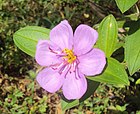Note: This is a project under development. The articles on this wiki are just being initiated and broadly incomplete. You can Help creating new pages.
Difference between revisions of "Melastoma malabathricum"
(→Uses) |
(→Mode of Propagation) |
||
| Line 49: | Line 49: | ||
==Where to get the saplings== | ==Where to get the saplings== | ||
==Mode of Propagation== | ==Mode of Propagation== | ||
| − | {{Propagation| | + | {{Propagation|Roots}}. |
==How to plant/cultivate== | ==How to plant/cultivate== | ||
Revision as of 14:05, 23 June 2020
Melastoma malabathricum, known also as Malabar melastome, Indian rhododendron, Singapore rhododendron, planter's rhododendron and senduduk, is a flowering plant in the family Melastomataceae.
Contents
- 1 Uses
- 2 Parts Used
- 3 Chemical Composition
- 4 Common names
- 5 Properties
- 6 Habit
- 7 Identification
- 8 List of Ayurvedic medicine in which the herb is used
- 9 Where to get the saplings
- 10 Mode of Propagation
- 11 How to plant/cultivate
- 12 Commonly seen growing in areas
- 13 Photo Gallery
- 14 References
- 15 External Links
Uses
Diarrhoea, Dysentery,Hemorrhoids,Wounds,Toothache.
Parts Used
Chemical Composition
Various phytochemical groups and constituents have been identified in M. malabathricum since 1968 and are strongly associated with its ethnomedicinal values. [1]
Common names
| Language | Common name |
|---|---|
| Kannada | ಅಂಕೇರ್ಕಿ Ankerki, ದೊಡ್ಡ ನೆಕ್ಕರೆ Dodda nekkare |
| Hindi | |
| Malayalam | Kalathi,Kadali |
| Tamil | Katalai |
| Telugu | Nekkare, Nekkaresaelya |
| Marathi | Lakeri, Palore |
| Gujarathi | NA |
| Punjabi | NA |
| Kashmiri | NA |
| Sanskrit | Tinisah |
| English | Malabar Melastome, Indian-rhododendron |
Properties
Reference: Dravya - Substance, Rasa - Taste, Guna - Qualities, Veerya - Potency, Vipaka - Post-digesion effect, Karma - Pharmacological activity, Prabhava - Therepeutics.
Dravya
Rasa
Guna
Veerya
Vipaka
Karma
Prabhava
Habit
Identification
Leaf
| Kind | Shape | Feature |
|---|---|---|
| Simple | Alternate | The leaves are light green and feathery with a bipinnate pattern |
Flower
| Type | Size | Color and composition | Stamen | More information |
|---|---|---|---|---|
| Unisexual | 1 inch | Light blue | 5 | Flowers Season is June - August |
Other features
List of Ayurvedic medicine in which the herb is used
- Vishatinduka Taila as root juice extract
Where to get the saplings
Mode of Propagation
How to plant/cultivate
Shrubs to 1.3 m tall; stem densely covered with paleaceous pectinate hairs. Leaves 4-11 x 1.5-4 cm, elliptic-oblong, base attenuate, apex acute, upper surface prominently lineolate; lower surface tomentose, 5-ribbed, drying dull-greenish; petiole to 1.5 cm long. Flowers solitary or few in rather dense clusters, c. 5 cm across; bracts 1.2-2 x 1-1.4 cm, boat-shaped, densely paleaceous hairy. Calyx tube 0.7-1 cm long, campanulate; lobes 5, 5-7 x 4-5 mm, ovate-lanceolate, densely paleaceous hairy. Petals 5, reddish purple, 1.5-2 x 0.7 - 1 cm, obovate. Stamens 10, alternating ones large and small; anthers dimorphic, dehiscence by apical pores. Ovary ovoid, 5-locular; ovules many; style simple. Capsules 1-1.5 x 0.8-1 cm, ovoid, irregularly dehiscent. Seeds many, minute. [4]
Commonly seen growing in areas
Photo Gallery
References
External Links
- Ayurvedic Herbs known to be helpful to treat Diarrhoea
- Ayurvedic Herbs known to be helpful to treat Dysentery
- Ayurvedic Herbs known to be helpful to treat Hemorrhoids
- Ayurvedic Herbs known to be helpful to treat Wounds
- Ayurvedic Herbs known to be helpful to treat Toothache
- Herbs with Leaves used in medicine
- Herbs with Shoots used in medicine
- Herbs with Barks used in medicine
- Herbs with Seeds used in medicine
- Herbs with common name in Kannada
- Herbs with common name in Malayalam
- Herbs with common name in Tamil
- Herbs with common name in Telugu
- Herbs with common name in Marathi
- Herbs with common name in Sanskrit
- Herbs with common name in English
- Habit - Herb
- Index of Plants which can be propagated by Roots
- Herbs that are commonly seen in the region of Tall grasslands
- Herbs that are commonly seen in the region of Meadows
- Herbs



